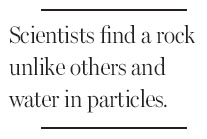Near-constant surprises of Mars
Updated: 2013-10-13 08:25
By Kenneth Chang(The New York Times)
|
|||||||||
It looked to be uniformly bland, which is why scientists chose it as the first rock to be examined last year by the Mars rover Curiosity: a run-of-the-mill volcanic rock, to test and calibrate the rover's instruments.
The rock turned out to be anything but ordinary, scientists reported in September. It is unlike any Mars rock previously examined and more like an Earth rock.
And as for the pile of windblown dust and soil that the rover spent weeks analyzing? It was not dry as dust, but contained water.
Such are the surprises that turn out to be a near constant of Mars exploration, according to six new papers on the planet that appeared recently - five in the journal Science and one in The Journal of Geophysical Research: Planets.
The new findings are "the nuts and bolts" of what Curiosity has discovered so far, said John P. Grotzinger, the mission's project scientist. On September 19, another paper from the science team reported that Curiosity had not detected any methane, which could have been a sign of present-day microbes. The mission is designed to see whether the building blocks of life existed on Mars, but includes no experiments to directly detect life.
In September last year, Curiosity rolled up to the volcanic rock, a pyramid-shaped chunk about the size of a football. The science team named it Jake M after Jacob R. Matijevic, a longtime rover engineer at NASA, the American Space Agency, who had died the month before. It appeared to be a chunk of basalt, like many others strewed on the surface. "Just featureless," said Edward M. Stolper of the California Institute of Technology.
Then the first readings came back. The mix of elements was different from that of other Martian basalts. "It just didn't look like any of the other guys," Dr. Stolper said. "I could tell that this was an unusual rock type and that it had characteristics that reminded me of certain kinds of terrestrial rocks."
The rock was alkaline, similar to a well-known but uncommon type of rock called mugearite, which is found on volcanic islands like Hawaii. "People say that less than 1 percent of the rocks on Earth are alkaline," Dr. Stolper said.

On Earth, the magma that hardens into alkaline rocks comes from the melting of rocks deep in the mantle in the presence of water. That suggests that the movement of magma and other geological processes within Mars may have been more complex than thought.
Last October, Curiosity visited the dirt pile and performed the first soil test in its chemistry laboratory. The fine dust was expected to be a mix of what is blowing around the planet.
When the dirt was heated, it released water vapor. Other analysis showed that the dirt and dust consisted of both tiny crystals where the atoms lined up in neat patterns and what the scientists called "amorphous" materials - the atoms jumbled up randomly, as in glass.
There was no evidence of water in the crystallized minerals, so all of the water - 2 percent by weight - was chemically bound up in the glassy particles.
"It's actually a fair amount," said Laurie A. Leshin of Rensselaer Polytechnic Institute in Troy, New York. "We always think of Mars as being this dry desert planet."
The water in the dust could be a resource for future astronauts, Dr. Leshin said.
The New York Times
(China Daily 10/13/2013 page11)